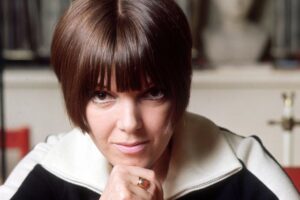
It wasn’t me or Courrèges who invented the miniskirt – it was the girls in the street who did it,” said Mary Quant of the revolutionary hemline she is widely credited with creating. The miniskirt was launched on King’s Road and immortalised in the Swinging Sixties, with Quant putting its success down to genetics: “The Chelsea girl had the best legs in the world. She had the courage to wear it.”
Despite it grabbing global press attention, not everyone was enamoured with the abbreviated skirt. Quant recalled how the stereotypical city gent, with his pinstriped suit and bowler hat, would beat Bazaar’s window with his brolly while shouting “Immoral!” and “Disgusting!”. Coco Chanel declared the miniskirt “indecent”. When Sophia Loren publicly claimed that the miniskirt had “destroyed the feminine mystique”, Quant replied: “Well, she’s built the other way up.”
Quant was born in Blackheath in 1934 to Welsh schoolteachers. Her mother was born in Kidwelly, her father in Merthyr, and each graduated with a first class honours degree from Cardiff University. Evacuated to a village in Kent with her brother Tony during the war, Quant recalled her earliest fashion memory as being in bed with measles at six years old and cutting the bedspread with nail scissors in order to transform it into a dress.
Her first successful encounter with needle and thread was an embroidered pillowcase she made for her mother at Christmas. When Quant was dispatched to a boarding school in Tunbridge Wells and presented with an exam question that asked her to choose between the Roundheads and the Cavaliers, Quant deemed it a no-brainer. “I came down strongly on the side of the Cavaliers, as they were more chic,” she said. On leaving school, she expressed her intention to pursue a career in clothes. Her parents were against the suggestion. Quant persuaded them to agree on the condition that she took an art teacher’s diploma.
Quant applied to and was accepted at Goldsmiths. Quentin Crisp was a resident model; Quant described him as “the most admired model and the most difficult to draw”. It was here that she met her future husband, the debonair Alexander Plunket Greene, in 1953 at a ball. Instantly besotted, she described him as “a 6ft 2in prototype for Mick Jagger and Paul McCartney rolled into one”. Quant was wearing “black mesh tights and strategically placed balloons” at the time.
